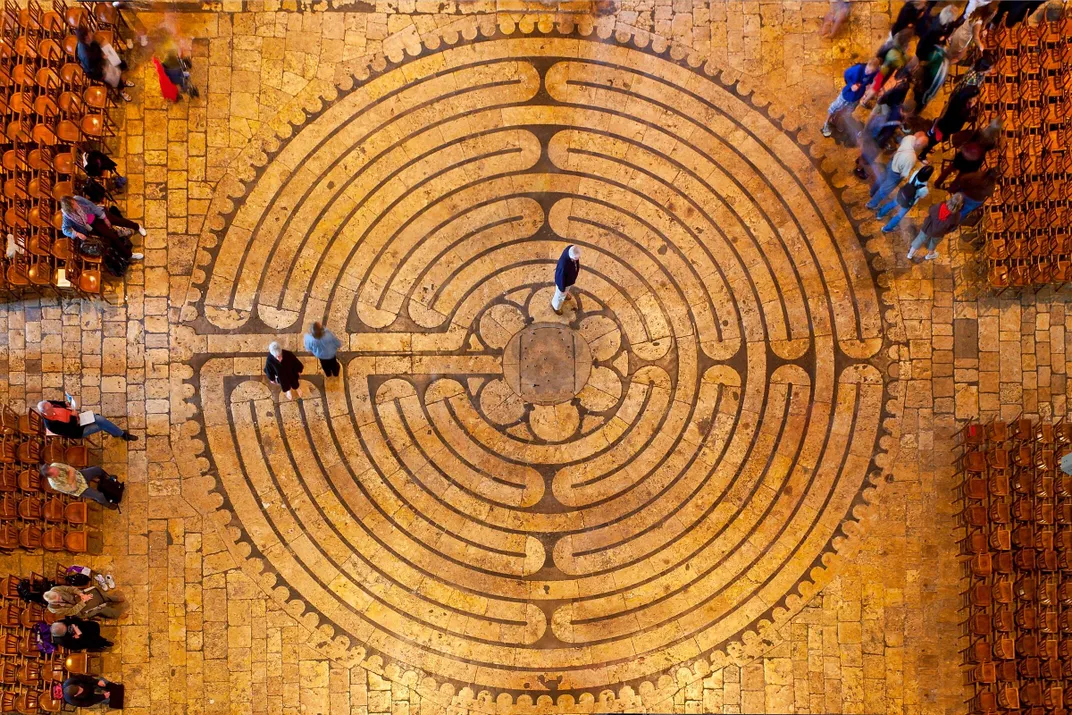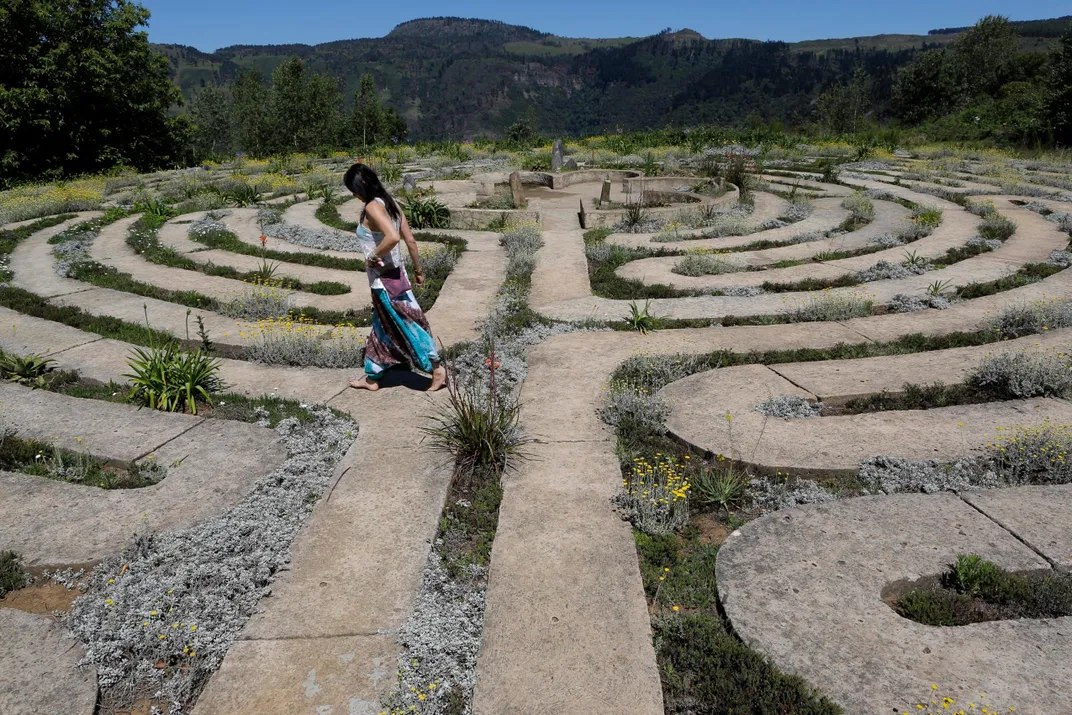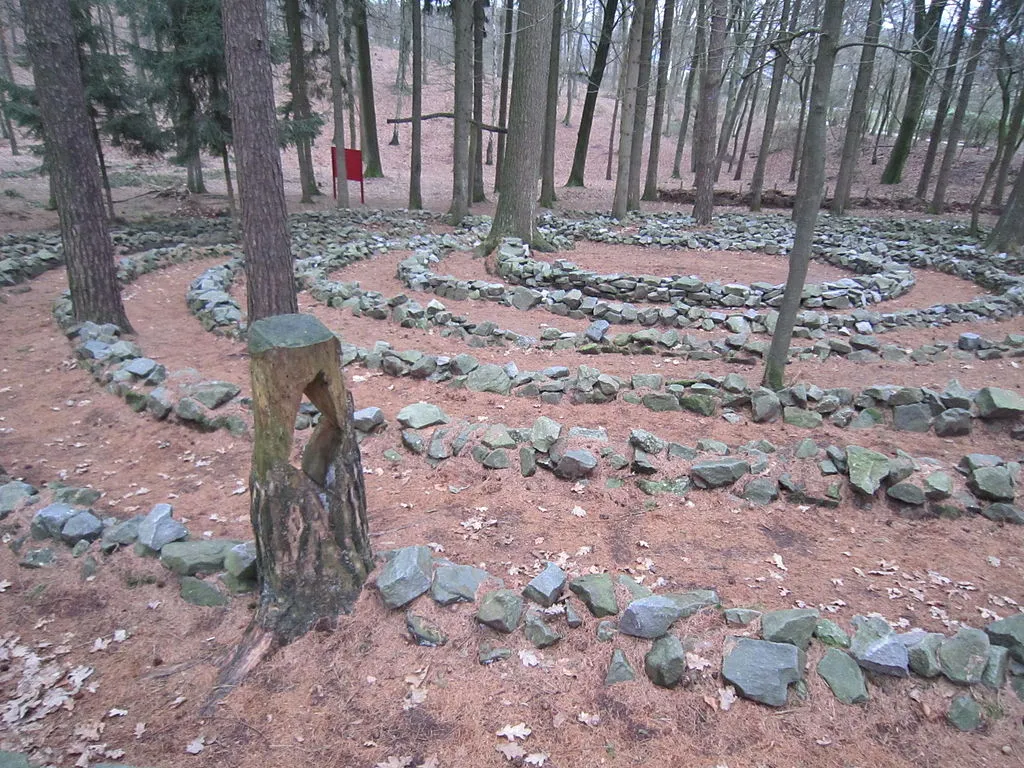Walk the World’s Most Meditative Labyrinths
History meets harmony on these time-worn paths
/https://tf-cmsv2-smithsonianmag-media.s3.amazonaws.com/filer/18/0e/180e7c39-5cfe-495e-8d8c-4b79abb4d54d/42-25883041.jpg)
Searching for enlightenment or just a scenic walk? Look for a labyrinth. Hiding in backyards, standing guard below a mountain, resting on the edge of a beach, shrouded by trees deep in the forest: Labyrinths can be found all over the world.
Beware—not all circuitous paths are labyrinths. Mazes, for example, are completely different; they may have one correct path, but are designed to trick someone into hitting a dead end or getting lost. If you associate the word “labyrinth” with the Minotaur of Daedalus or David Bowie’s Goblin King, you’ve been mislead. Unlike those pop culture mazes, real labyrinths only have one route and contain no wrong turns. They aren’t puzzles; they are meditations.
These complex single-track circuits didn’t evolve from fictional accounts—rather, they were in use long before recorded history. Historians separate labyrinths into types based on their shape and time period. All are unicursal, featuring a single path that leads into the center of an intricately wound space and then back out. They can be considered left-handed or right-handed, too, depending on the direction of the first turn.
Pictures of ancient labyrinths can be found on rock carvings, petroglyphs and elaborate inscriptions. One of the most famous labyrinths of the ancient world was housed in an Egyptian pyramid complex built in the 12th Dynasty (1844-1797 B.C.) at Hawara by Amenemhet III. Labyrinth lovers prize a stone tablet that dates from approximately 1200 B.C., David Gallagher, executive director for The Labyrinth Society, tells Smithsonian.com. “That comes from the dig at the Mycenaean Palace in Greece. It’s on a clay tile, and on the other side is an inventory list for the palace kitchen.” The seven-circuit path it represents is a prime example of the Classical era of labyrinth building.
With the rise of the Roman Empire, the classical circle flattened into a square. The new Roman style of labyrinth was used in intricate tile patterns in bathhouses, tombs, and homes. In the ninth century, labyrinths moved back to their circular form, but with more circuits. The floor of Chartres Cathedral in France, which remains one of the most-walked labyrinths today, is the most famous Medieval labyrinth.
Historically, walking a labyrinth is associated with religious and magical experiences. Their many ins and outs are often associated with mythical figures, and in the past they were walked as devotional activities, mini-pilgrimages or atonements for some sin. Nordic pagans coursed the paths as a way to overcome difficulty, reinforce protection and bring good fortune. These days, walkers choose labyrinths for a meditative experience of repetition and slight concentration contained in a small circular package. The journey is a personal one—everyone gets something different out of the winding walk.
“It’s unpredictable,” says Gallagher. “I can’t tell you what a specific individual should expect to experience. Ask anyone who’s interested in labyrinths and you’ll get different answers.” Gallagher, who associates his walks with transcendent personal experiences, admits that they aren’t for everyone. Some people will walk through them and feel nothing, he says. But that’s all part of the mystery.
Looking for a labyrinthine addition to your next trip? Check out the World-Wide Labyrinth Locator. The database is searchable by location and type. Currently, the site lists 4,977 labyrinths in 80 countries—a fitting addition to any patient traveler’s itinerary. Here are six specimens heralded for their beauty and history:
Chartres Cathedral (Chartres, France)

The labyrinth at Chartres Cathedral dates back to 1205, when monks used it for contemplative moments. These days, it’s one of the world’s best-known labyrinths. Pilgrims still come from around the world to traverse it—but only on Fridays during the summer, when it’s not covered with chairs for church services. Scholars believe that the path symbolizes the human journey from sin to redemption.
Old Summer Palace (Beijing, China)

Walk through a labyrinth surrounded by ruins at the Qing Dynasty’s summer palace, built in 1709. The path is housed in a garden called Yuanmingyuan, or the Garden of Perfection and Light. The area was originally meant to be a more than 864-acre private pleasure garden for Chinese emperors, but it was destroyed in the 1860s by British and French forces who plundered and then burned the garden in retribution for prisoner deaths. The garden’s history may be tragic, but the remaining ancient landscaping gives a walk in the surviving labyrinth a completely unique twist.
Dunure Castle (Scotland, United Kingdom)

China isn’t the only place where you can walk a labyrinth within view of ruins. Look for a labyrinth near Scotland’s crumbling Dunure Castle, a 13th century stronghold and the original home of the Kennedys of Carrick, who controlled most of southwest Scotland at the time. The stone labyrinth sits beachside near a park and looks down the shoreline, giving labyrinth walkers a spectacular view of the castle’s remains.
Lands End (San Francisco, California)

Artist Eduardo Aguilera originally built Lands End labyrinth in secrecy in 2004. Located on a craggy outcropping at the edge of San Francisco’s Mile Rock Beach overlooking the Golden Gate Bridge, the path is tucked away from view. But that hasn’t stopped vandals from targeting it. At least three times since it was built, the labyrinth has been destroyed in the dead of night. By now, though, the labyrinth is such a revered place that it’s always rebuilt within days, most recently by the labyrinth’s unofficial caretaker and a group of 50 volunteers.
The Edge (Hogsback, South Africa)

Tucked in the Amathole Mountains in South Africa is one long labyrinth. Clocking in at nearly one mile long, The Labyrinth at The Edge Mountain Retreat overlooks a stunning backdrop of mountains and forest. Hogsback is known for its dreamy landscape and is a favorite destination for crystal healers, yogis and spiritual explorers—the perfect locale for a leisurely stroll.
Damme Priory (Damme, Germany)

Forest lovers flock to the labyrinth at Damme Priory, where a rock-hewn path is interspersed with trees in the middle of the woods. Münsterschwarzach Abbey, the Benedictine monastery that owns the property, has been in place since the 700s and owns a similar labyrinth in Bavaria. But the smaller one in Damme is special—since it’s so tucked away, it can seem like you’re the only person around, enabling a truly meditative experience.
Planning Your Next Trip?
Explore great travel deals
Smithsonian magazine participates in affiliate link advertising programs. If you purchase an item through these links, we receive a commission.
/https://tf-cmsv2-smithsonianmag-media.s3.amazonaws.com/accounts/headshot/JenniferBillock.png)


/https://tf-cmsv2-smithsonianmag-media.s3.amazonaws.com/accounts/headshot/JenniferBillock.png)